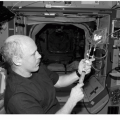Aviation, Government Space, Biomedical Innovations, and Education
Jeffrey R. Davis
The human bird shall take his first flight, filling the world with amazement, all writings with his fame, and bringing eternal glory to the nest whence he sprang.
—Leonardo da Vinci
I confess that in 1901, I said to my brother Orville that man would not fly for fifty years … Ever since, I have distrusted myself and avoided all predictions.
—Wilbur Wright
The challenge of the great spaces between the worlds is a stupendous one; but if we fail to meet it, the story of our race will be drawing to its close. Humanity will have turned its back upon the still—untrodden heights and will be descending again the long slope that stretches, across a thousand million years of time, down to the shores of the primeval sea.
—Arthur C. Clarke
I don’t think the human race will survive the next thousand years, unless we spread into space. There are too many accidents that can befall life on a single planet. But I’m an optimist. We will reach out to the stars.
—Stephen Hawking
We are at the beginning of a renaissance in aerospace medicine in the diversity and scope of practice. The following two chapters (29 and 30) highlight the emerging and potential developments in commercial aviation, government and commercial space programs, biomedical innovations, and education that will expand opportunities in, and biomedical applications for, aerospace medicine. The aerospace medicine practitioner will have to be a generalist and conversant in many existing and emerging fields of medicine, science and engineering, and developing aircraft and spacecraft, to
provide the same level of care to future crews that is provided now. The challenge for educational programs is to provide the appropriate mix of academic knowledge and practical experiences to provide the new practitioner with the tools to succeed. Educational programs should strive to teach aerospace medicine as an integrated field from aviation to space.
provide the same level of care to future crews that is provided now. The challenge for educational programs is to provide the appropriate mix of academic knowledge and practical experiences to provide the new practitioner with the tools to succeed. Educational programs should strive to teach aerospace medicine as an integrated field from aviation to space.
DEVELOPMENTS IN AVIATION
General Aviation
One recent development in general aviation is the development of the sport pilot category with emergence of a new industry in light sport aircraft. Pilot medical and training requirements have been reduced for this category. Although the authors note that this rule has stimulated the light sport aircraft industry, they caution that the impact of reduced medical certification on aircraft mishaps from pilot medical or judgment issues is unknown at this time. Data will need to be collected and evaluated over many years to determine the accident/mishap rate, and root causes, in the sport pilot category (see Chapter 27). The hope is that an appropriate balance is found between stimulating general aviation and regulatory concerns.
Commercial Aviation
The 2007-2020 U.S. Federal Aviation Administration (FAA) Aerospace Forecast predicts that U.S. commercial aviation will carry 1 billion passengers by 2015 and 1.2 billion by 2020 (1). This forecast predicts 62.5 million take-offs and landings at U.S. towered airports during 2007, and 81.1 million by 2020. This represents an average growth of 1.4 million take-offs and landings per year during the forecast period. In addition, general aviation flying hours are also expected to increase 59% by 2020. The future may hold a greater number of aircraft flying point-to-point to decrease traffic in the terminal areas and increase efficiency. The predicted growth in U.S. civil aviation operations will also require an increase in the number of civil aviation flight crews and other support personnel, which, in turn, will increase the demand for aerospace medicine personnel to provide a broad spectrum of essential medical services.
Airport Medical Services
The expected growth in commercial civil aviation activity is likely to generate an increasing demand for airport emergency medical services to accommodate the medical needs of the increasing number of passengers who will be in transit through national and international airports. The availability of airport medical services will be particularly important considering the aging nature of the flying passenger population around the world and the increased potential for medical events in this population.
Very Light Jets
The introduction of very light jets (VLJs) is expected to revolutionize and promote the growth of the on-demand air-taxi transportation system and the corporate aviation sector (including fractional ownership programs). The FAA predicts that 250 VLJs will be added to the U.S. aircraft fleet in 2008, and the growth of this fleet will continue at a rate of 400 to 500 more per year through 2020. Most of these aircraft will be used for single-pilot commercial aviation operations that will emphasize the importance of ensuring pilot fitness for flight in view of the elimination of flight crew redundancy in some of these operations.
Commercial Transports
A new generation of comfort-oriented commercial transports such as the Boeing 787 (B-787) and the Airbus 350 (A-350) will fly at higher altitudes, at lower cabin altitudes, and will provide passengers with larger size passenger windows. The use of lower cabin altitudes will potentially benefit those passengers who have a variety of medical conditions that make them more susceptible to the adverse physiological effects of hypoxia, especially during long-duration flights. Flying at higher altitudes will result in less turbulence during flight, which will likely benefit those passengers who have a predisposition to motion sickness. The production of advanced aircraft that utilize a new generation of engines that are more fuel-efficient and reliable, incorporate more structural elements made of composite materials and alloys that are lighter and stronger, and take advantage of improved aerodynamic designs, will promote the continued expansion of ultra-long commercial flight operations. Appropriate safety procedures must be implemented to prevent any potential negative impacts of such long flights on flight crew performance, as well as the potentially adverse aeromedical impact of these flights on passenger health and comfort.
Aviation Safety
Civil aviation accounts for approximately 600 to 700 deaths annually and most occur in general aviation. The National Transportation Safety Board (NTSB) reported that in 2006 general aviation recorded the lowest number of accidents and fatalities in the last 40 years (2). Major air carriers operating larger aircraft between major airports have the lowest accident rates in civil aviation.
The NTSB list of “Most Wanted” air transportation safety improvements in the United States includes: (a) reduce the dangers to aircraft flying in icing conditions, (b) eliminate flammable fuel/air vapors in fuel tanks on transport category aircraft, (c) stop runway incursions and ground collisions of aircraft, (d) improve audio and data recorders and require video recorders, (e) reduce accidents and incidents caused by human fatigue, and (f) improve crew resource management in Part 135 operations (3).
Global Public Health
In Chapter 28, several new activities in international civil aviation were highlighted that are likely to expand. In 2004, the International Civil Aviation Organization (ICAO) assembly decided to add passenger and crew health in its definition of safety. The ICAO Council was charged to review
existing, and develop new, Standards and Recommended Practices (SARPs) for global health issues including the potential for spreading communicable diseases by aircraft. The World Health Organization (WHO) developed a Transportation Working Group, and two aviation medicine specialists participated in the revision of the International Health Regulations (IHR). The revisions of the IHR seek to improve international surveillance and communication of public health issues. Therefore, the aerospace medicine practitioner will need substantial training in public health and an awareness of global health issues and surveillance mechanisms. Practitioners should anticipate consultation requests about global health issues with governments and the private sector as commercial aviation capacities increase for range, city connections, and number of passengers.
existing, and develop new, Standards and Recommended Practices (SARPs) for global health issues including the potential for spreading communicable diseases by aircraft. The World Health Organization (WHO) developed a Transportation Working Group, and two aviation medicine specialists participated in the revision of the International Health Regulations (IHR). The revisions of the IHR seek to improve international surveillance and communication of public health issues. Therefore, the aerospace medicine practitioner will need substantial training in public health and an awareness of global health issues and surveillance mechanisms. Practitioners should anticipate consultation requests about global health issues with governments and the private sector as commercial aviation capacities increase for range, city connections, and number of passengers.
Military Aviation
In military aviation, the development of vectored thrust will produce aircraft with greater maneuverability that increases the potential for complicated acceleration environments (see Chapter 4). These multi-G environments likely will increase the physiological stress on the aviator requiring more sophisticated protective equipment that has the capability to automatically initiate action to protect the pilot. Aircrew will fly longer missions, and worldwide deployment will raise global public health issues (see Chapters 26 and 28). The development of Unmanned Aircraft Systems (UAS) produces concern over operator error and fatigue (see Chapter 23), and appropriate medical certification for operators (see Chapter 27).
DEVELOPMENTS IN GOVERNMENT SPACE PROGRAMS
Exploration beyond low Earth orbit (LEO) is once again at the forefront of planning for many nations. In the United States, National Aeronautics and Space Administration (NASA) released “The Vision for Space Exploration” (4) in February 2004 that initiated the development of the Constellation program within NASA. NASA programs will be presented in more detail (see subsequent text) with a brief description of some of the announced plans of other national space agencies. Several current planning efforts note that exploration is an international endeavor (see subsequent text).
James A. Baker Institute for Public Policy
In May 2007, the James A. Baker Institute for Public Policy, at Rice University in Houston, Texas, convened a 2.5 day summit about the future issues and challenges facing space medicine. This International Space Medicine Summit involved the participation of leading international members of the space community from government and academia. Perspectives were obtained from crewmembers, space medicine physicians, and biomedical researchers, as well as administrators and planners. Comprehensive panel discussions were held about the many challenges of long-duration space flight, especially when traveling beyond LEO. Published proceedings are pending from this workshop.
Center for Strategic and International Studies
The Center for Strategic and International Studies (CSIS) is a nonprofit, bipartisan public policy organization established in 1962 to address international policy issues. In the summer of 2003, CSIS began a Human Space Exploration Initiative (HSEI) to examine the future of human space exploration and the range of exploration visions from the world’s space faring nations. The HSEI produced a 2005 report titled “The Still Untrodden Heights: Global Imperatives for Space Exploration” in the 21st Century” (5). According to the report, the purpose of the HSEI is “to explore new international perspectives on the future of human presence in space, assess their relative prospects, and build a new common global vision and agenda for the future of human space exploration.” In 2004, the project team met with public and private members of the space community from around the world and held workshops on key issues.
The report noted five major recommendations that are briefly extracted here and the interested reader is referred to the full report that can be downloaded from the CSIS website (5).
Establish an International Year of Space Exploration in 2011 that will be the 50th anniversary of human space flight, commemorating Yuri Gagarin’s and Alan Shepard’s first flights.
Create a new International Space Governance Forum that could share best practices across borders among other suggestions.
Charter a new Global Venture Fund for space exploration to encourage innovative research.
Establish an International Prize for space exploration to reward and provide incentives for the greatest contributions to space exploration activities.
Make a renewed international commitment to space education through national governments and the private sector.
Global Exploration Strategy
Fourteen space agencies, through workshops in 2005 and 2006, collaborated in writing “The Global Exploration Strategy: the Framework for Coordination” May 2007 (6). Some of the space agencies that participated included the NASA, the China National Space Administration (CNSA), the European Space Agency (ESA), the Canadian Space Agency (CSA), the Japan Aerospace Exploration Agency (JAXA), and Roscosmos (Russia). The report concluded, “sustainable space exploration is a challenge that no one nation can do on its own.” (6). These 14 space agencies developed the framework to present a vision for robotic and human space exploration, and to elaborate an action plan for sharing strategies so that all programs may be more effective and safe. The framework recommends a voluntary, nonbinding forum, the International Coordination Mechanism, through which nations can
collaborate. A third workshop was held from May 30 to June 1, 2007 to discuss this Coordination Mechanism. In addition to science and technology development, the report notes that space exploration offers entrepreneurial opportunities by creating a demand for new technologies and services.
collaborate. A third workshop was held from May 30 to June 1, 2007 to discuss this Coordination Mechanism. In addition to science and technology development, the report notes that space exploration offers entrepreneurial opportunities by creating a demand for new technologies and services.
Stay updated, free articles. Join our Telegram channel

Full access? Get Clinical Tree







